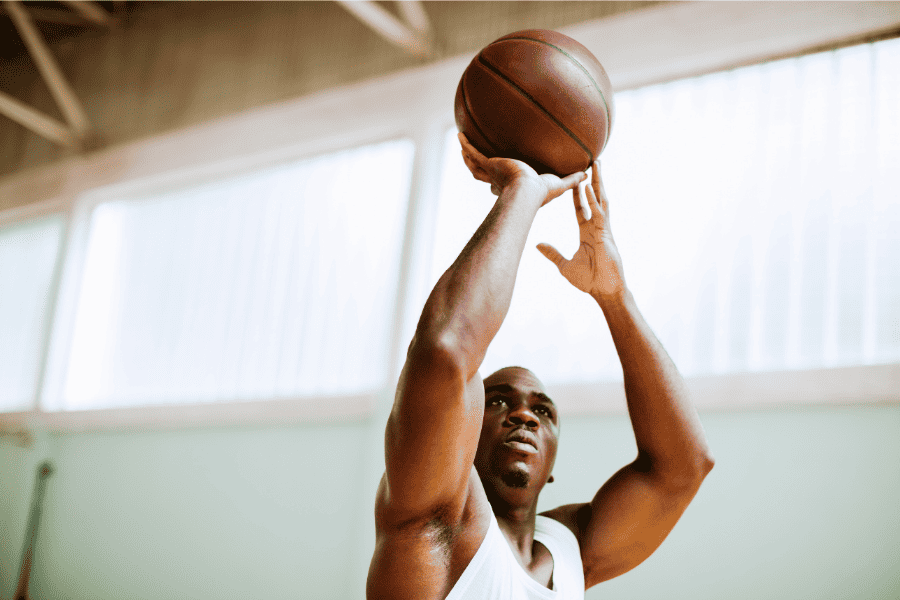What Does a Power Forward Do in Basketball?
In the sport of basketball, the power forward (PF), also known as the ‘four’, is one of the five positions on the court.
Traditionally, the power forward is often one of the larger players on the team, both in terms of height and muscle. Their role involves a mix of scoring, rebounding, and defense, requiring them to be versatile and capable in both the paint (the area directly underneath and immediately adjacent to the basket) and in mid-range areas of the court.
While they primarily operate close to the basket, in recent years, the role has evolved to often include more perimeter play and shooting.
Role and Responsibilities of a Power Forward
Offensive Responsibilities
Scoring Close to the Basket
One of the primary offensive responsibilities of a power forward is scoring close to the basket. This is often achieved through post-up plays where the power forward uses their body to gain advantageous positioning near the basket against a defender, allowing for a relatively close and often uncontested shot.
Power forwards also frequently score off rebounds, using their height and strength to secure offensive rebounds and then immediately going up for a shot. Their size, strength, and agility can make them dominant forces in the paint, capable of powering through defenders or skillfully maneuvering around them to score.
Mid-Range Shooting

Another essential component of a power forward’s offensive responsibilities is mid-range shooting. This ability provides an additional scoring threat, forcing defenders to guard them further from the basket and thus opening up the court for their teammates.
Mid-range shooting skills also allow power forwards to be effective in pick-and-pop situations, where they set a screen and then move away from the basket to receive a pass and take an open shot.
Power forwards like Tim Duncan and Kevin Garnett were renowned for their ability to consistently hit mid-range shots, making them extremely valuable offensive assets for their teams.
Setting Screens for Teammates
A crucial yet often overlooked role of the power forward on offense is setting screens for their teammates. A well-set screen can help a teammate get free of a defender and create an open shot or a driving lane to the basket.
Power forwards are particularly well-suited to this role due to their size and strength, which allows them to effectively block defenders. The pick-and-roll (where the power forward sets a screen and then moves toward the basket to receive a pass) and the aforementioned pick-and-pop are common plays in basketball that heavily rely on the screen-setting capabilities of the power forward.
Furthermore, their ability to set solid screens and then either roll to the basket or pop out for a shot adds a layer of unpredictability to the offense, making it harder for the opposing team to defend.
Defensive Responsibilities
Rebounding
On the defensive end, one of the most critical tasks of a power forward is rebounding. Given their size and proximity to the basket, they are often in the best position to retrieve missed shots from both their team and the opposing team.
Defensive rebounding is particularly important as it prevents the opposing team from getting second-chance points and allows the power forward’s team to gain possession of the ball.
Power forwards like Dennis Rodman and Tim Duncan were renowned for their exceptional rebounding abilities, often outmuscling and out-jumping opponents to secure the ball.
Blocking and Altering Shots

Another defensive responsibility of power forwards is blocking and altering shots. This involves using their size and athleticism to prevent or disrupt opponents’ shot attempts.
Blocking a shot outright not only prevents the opposition from scoring but can also lead to fast-break opportunities for the power forward’s team. Even if they don’t block the shot, a well-positioned power forward can alter the trajectory of a shot or force the opponent to adjust their shot in mid-air, both of which can lead to missed shots.
Players such as Serge Ibaka and Tim Duncan (5th all-time in blocked shots) have made names for themselves through their impressive shot-blocking abilities.
The Skill Set of a Power Forward
Physical Attributes: Height, Strength, and Agility
Power forwards in basketball often possess a combination of physical attributes that allow them to fulfill their roles effectively.
Traditionally, they are among the taller players on the court, usually standing 6’8″ or above, which gives them an advantage when it comes to rebounding and shot-blocking. In addition to height, power forwards typically have significant strength, allowing them to hold their ground against opposing players in the paint and to power through defenders to score.
However, merely being tall and strong is not enough. Agility is another key attribute for power forwards, as it allows them to keep up with smaller, quicker players on defense, to maneuver around defenders when close to the basket, and to transition quickly between offense and defense.
Players such as Anthony Davis and Giannis Antetokounmpo, who are both tall and agile, exemplify the modern power forward’s physical attributes.
Skills Required
Ball-Handling
While not traditionally known for their ball-handling skills, modern power forwards are often adept at dribbling and controlling the ball. This allows them to take advantage of mismatches against slower defenders, create their own shots, and even initiate the offense at times.
Power forwards like Draymond Green and Giannis Antetokounmpo have demonstrated high levels of ball-handling skill, broadening the scope of what a power forward can contribute on offense.
Shooting
Shooting is an essential skill for power forwards, both from close range and further out. This includes the ability to make layups and dunks close to the basket, mid-range jump shots, and increasingly, three-point shots.
A power forward who can shoot effectively from long range, sometimes referred to as a “stretch four”, is a valuable asset in modern basketball as they can spread the defense and create more space for their teammates.
Dirk Nowitzki, one of the greatest shooting power forwards of all time, revolutionized the position with his scoring ability from all areas of the court.
Passing
Although not traditionally associated with the power forward position, passing has become an increasingly important skill. A power forward who can pass effectively can contribute to their team’s offense by finding open teammates, setting up scoring opportunities, and even acting as a secondary playmaker.
This skill adds another layer of versatility to a power forward’s game and makes the team’s offense more dynamic and unpredictable.
Defensive Capabilities
Rim Protection
Rim protection is one of the most crucial defensive responsibilities for a power forward (along with the Center). This role involves guarding the area around the basket or the “rim” to prevent easy scores from opposing players.
Power forwards accomplish this through shot blocking, altering shot trajectories, or simply by establishing a presence that deters opponents from driving to the basket.
One-on-One Defense

One-on-one defense, particularly in the low post, is another essential skill for power forwards.
This requires strength to resist being backed down towards the basket, quickness to react to the offensive player’s moves, and a good understanding of defensive principles to contest and prevent shots effectively without fouling.
Defensive IQ and Reading Plays
Defensive intelligence, or defensive IQ, is a vital attribute for power forwards. This refers to the ability to read and anticipate the offensive team’s plays, knowing when to switch on defense, when to double-team an opponent, and when to rotate to cover a teammate’s position.
A high defensive IQ also involves understanding the tendencies of individual opponents, such as which hand they prefer to use, their favorite moves, or whether they tend to pass or shoot in certain situations.
Notable Power Forwards and Their Impact on the Game
Tim Duncan
Known as “The Big Fundamental”, Tim Duncan is one of the greatest power forwards in the annals of basketball. His entire 19-season career spent with the San Antonio Spurs saw him display an all-around game marked by consistent scoring, effective rebounding, and exceptional defense.
His mastery of fundamental skills, a high basketball IQ, and his poised demeanor all contributed to his central role in the Spurs’ championship success.
Dirk Nowitzki
A towering figure in the game, Dirk Nowitzki redefined the power forward position during his illustrious 21-year career with the Dallas Mavericks.
Hailing from Germany, Nowitzki brought a unique European style to the NBA, combining his 7-foot frame with exceptional shooting skills. Known for his signature “fadeaway” shot, Nowitzki was a scoring machine, becoming the highest-scoring foreign-born player in NBA history.
Kevin Garnett
Kevin Garnett, or “The Big Ticket”, was an intense and passionate player known for his versatility. Spending the majority of his career with the Minnesota Timberwolves and Boston Celtics, Garnett was both a formidable scorer and a tenacious defender.
His ability to guard multiple positions, shoot from mid-range, and contribute as a playmaker revolutionized the power forward position and set the stage for the next generation of versatile big men.
How these Players Defined and Redefined the Power Forward Role
These iconic power forwards each brought their unique attributes and skills to redefine the position in their own ways.
Tim Duncan, with his fundamental approach to the game and basketball intelligence, highlighted the significance of consistency, versatility, and team play for power forwards. He managed to dominate both ends of the court while always making the right play, setting a standard for future power forwards.
Dirk Nowitzki, with his combination of size and exceptional shooting skills, introduced a new era of “stretch fours” in basketball. His unique playing style, characterized by a soft shooting touch and unmatched scoring ability, demonstrated that power forwards could not only score but also create space and opportunities for their teammates.
Kevin Garnett expanded the boundaries of the power forward role with his intensity, versatility, and passion for the game. His ability to shoot, pass, defend, and occasionally lead the offense blurred the traditional positions in basketball, paving the way for the era of positionless basketball we see today.
Through their unique skills and contributions, these players have each left an indelible mark on the power forward position and continue to influence the way the game is played today.
The Modern Power Forward: Changes and Evolution
The trend towards “small ball” and positionless basketball has significantly impacted the power forward position.
Small ball, characterized by lineups featuring smaller, more versatile players, often requires power forwards to defend quicker guards and wings, necessitating greater speed and agility.
Simultaneously, positionless basketball, where players are expected to fulfill multiple roles traditionally associated with different positions, has increased the skill set demanded of power forwards.
They may be expected to handle the ball, distribute it like a point guard, or shoot from long range like a shooting guard, while still fulfilling their traditional responsibilities of rebounding and defending the paint.
The Rise of the ‘Stretch Four’
The “stretch four” is a term used to describe power forwards who possess the ability to shoot effectively from the three-point line. This skill “stretches” the defense, forcing opposing big men to guard them on the perimeter and thus creating more space for their teammates to operate.
Players like Dirk Nowitzki and Kevin Love were instrumental in popularizing this role, and in the modern game, an outside shooting touch has become almost a requirement for power forwards. This evolution has expanded the power forward’s offensive role and further blurred the lines between positions.
Modern Power Forwards are Expected to Play Multiple Roles
In today’s game, power forwards are not confined to traditional roles; instead, they are expected to contribute in a variety of ways on the court. In addition to scoring and rebounding, modern power forwards might also be expected to create plays for others, handle the ball, and defend multiple positions.
Draymond Green of the Golden State Warriors is an excellent example of this type of player. Despite not being a prolific scorer, Green significantly impacts games with his playmaking, defense, and leadership.
His versatility allows him to play multiple roles depending on his team’s needs, epitomizing the multifaceted nature of the modern power forward.
Overall, the power forward position has undergone significant changes and continues to evolve. These changes reflect the broader shifts in the game of basketball towards versatility, spacing, and multi-skilled players, ensuring that the power forward remains a pivotal position on any basketball team.
Final Thoughts
The role of a power forward in basketball has evolved significantly over the years, adapting to the changes in the game’s strategies and styles.
Traditionally, power forwards were primarily responsible for scoring close to the basket, rebounding, and playing defense in the paint. However, with the development of small ball and positionless basketball, and the rise of the ‘stretch four’, the power forward’s role has expanded to include a broader set of skills and responsibilities.
Modern power forwards are now expected to be multifaceted, demonstrating abilities such as long-range shooting, ball handling, and playmaking, along with traditional tasks like rebounding and interior defense. This evolution has blurred the lines between traditional basketball positions and paved the way for a more dynamic, versatile style of play.
By better understanding the power forward position, fans and players can enhance their appreciation of basketball, gaining a deeper grasp of its intricacies, strategies, and the unique roles that different players bring to the court.

